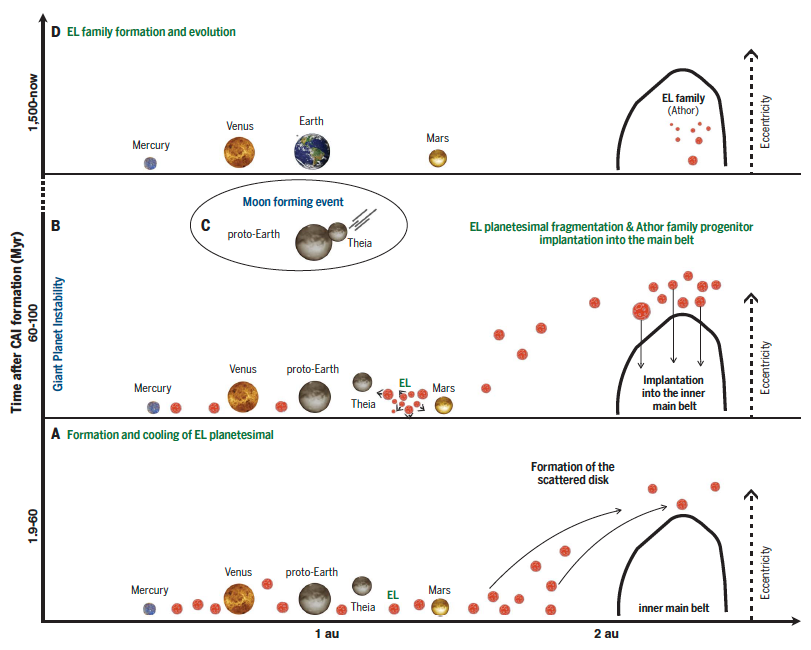Enstatite chondrite meteorites date the giant planet instability
- 1University of Leicester, School of Physics and Astronomy, Leicester, United Kingdom of Great Britain – England, Scotland, Wales (ca337@leicester.ac.uk)
- 2Laboratoire Lagrange, CNRS, Observatoire de la Côte d'Azur, Université Côte d’Azur, Nice, France
- 3Southwest Research Institute, Boulder, CO, USA
- 4College de France, CNRS, Université Paris Sciences et Lettres, Sorbonne Université, Paris, France
The identification of meteorite parent bodies provides the context for understanding planetesimal formation and evolution as well as the key solar system dynamical events they have witnessed. We identified that the family of asteroid fragments whose largest member is asteroid (161) Athor is the unique source of the rare EL enstatite chondrite meteorites (Avdellidou et al. 2022), the closest meteorites to Earth in terms of their isotopic ratios. The Athor family was produced by the collisional fragmentation of a parent body 3 Gyr ago in the inner main belt (Delbo et al. 2019), however the diameter of the Athor family progenitor was much smaller than the putative size of the EL original planetesimal (Triellof et a. 2022). Therefore, we deduced that the EL planetesimal that accreted in the terrestrial planet region underwent a first catastrophic collision in that region, and one of its fragments (the progenitor of the Athor family) suffered a more recent catastrophic collision in the main belt, generating the current source of the EL meteorites.
How and when did the Athor family progenitor implanted into the inner main belt?
To answer this question we used an interdisciplinary methodology where we combined laboratory meteorite thermochronometric data, thermal modelling, and dynamical simulations.
First we showed that planetesimal fragments from the terrestrial planet zone must have been implanted into the main asteroid belt at least 60 Myr after the beginning of the solar system in order to explain the EL thermochronometric data. Then we investigated the possible dynamical ways that could have implanted the Athor family progenitor in its current position in the inner main belt.
We concluded that the giant planet instability is the only dynamical process that can enable such implantation so late in the solar system timeline (Avdellidou et al. 2024). The low limit of the instability window at 60 Myr is defined by the earliest time that the EL planetesimal could have been broken, while the upper limit at 100 Myr had been defined by the survival of the Patroclus-Menoetius Jupiter trojan binary asteroid (Nesvorny et al. 2018). The giant impact that formed the Moon occurred within this range, so it might be related to the giant planet instability.

Acknowledgements. We acknowledge support from the ANR ORIGINS (ANR- 18-CE31-0014) and European Research Council advanced grant no. 101019380. This work is based on data provided by the Minor Planet Physical Properties Catalogue (MP3C) of the Observatoire de la Côte d’Azur (mp3c.oca.eu).
References
Avdellidou, Delbo, A. Morbidelli, Walsh, Munaibari, Bourdelle de Micas, Devogèle, Fornasier, Gounelle, & van Belle. Athor asteroid family as the source of the EL enstatite meteorites, 2022, A&A, 665, id.L9, 13 pp.
Delbo, Avdellidou, & Morbidelli, Ancient and primordial collisional families as the main sources of X-type asteroids of the inner main belt, 2019, A&A, 624, A69
Trieloff, Hopp & Gail. Evolution of the parent body of enstatite (EL) chondrites, 2022, Icarus, 373, 114762
Nesvorny,Vokrouhlický, Bottke, Levison, Evidence for very early migration of the Solar System planets from the Patroclus-Menoetius binary Jupiter Trojan, 2018, Nature Astronomy, 2, 878–882
Avdellidou, Delbo, Nesvorny, Walsh, Morbidelli, Dating Solar System's giant planet instability with enstatite meteorites, 2025, Science, 384, 348–352
How to cite: Avdellidou, C., Delbo, M., Nesvorny, D., Walsh, K., and Morbidelli, A.: Enstatite chondrite meteorites date the giant planet instability , Europlanet Science Congress 2024, Berlin, Germany, 8–13 Sep 2024, EPSC2024-409, https://doi.org/10.5194/epsc2024-409, 2024.